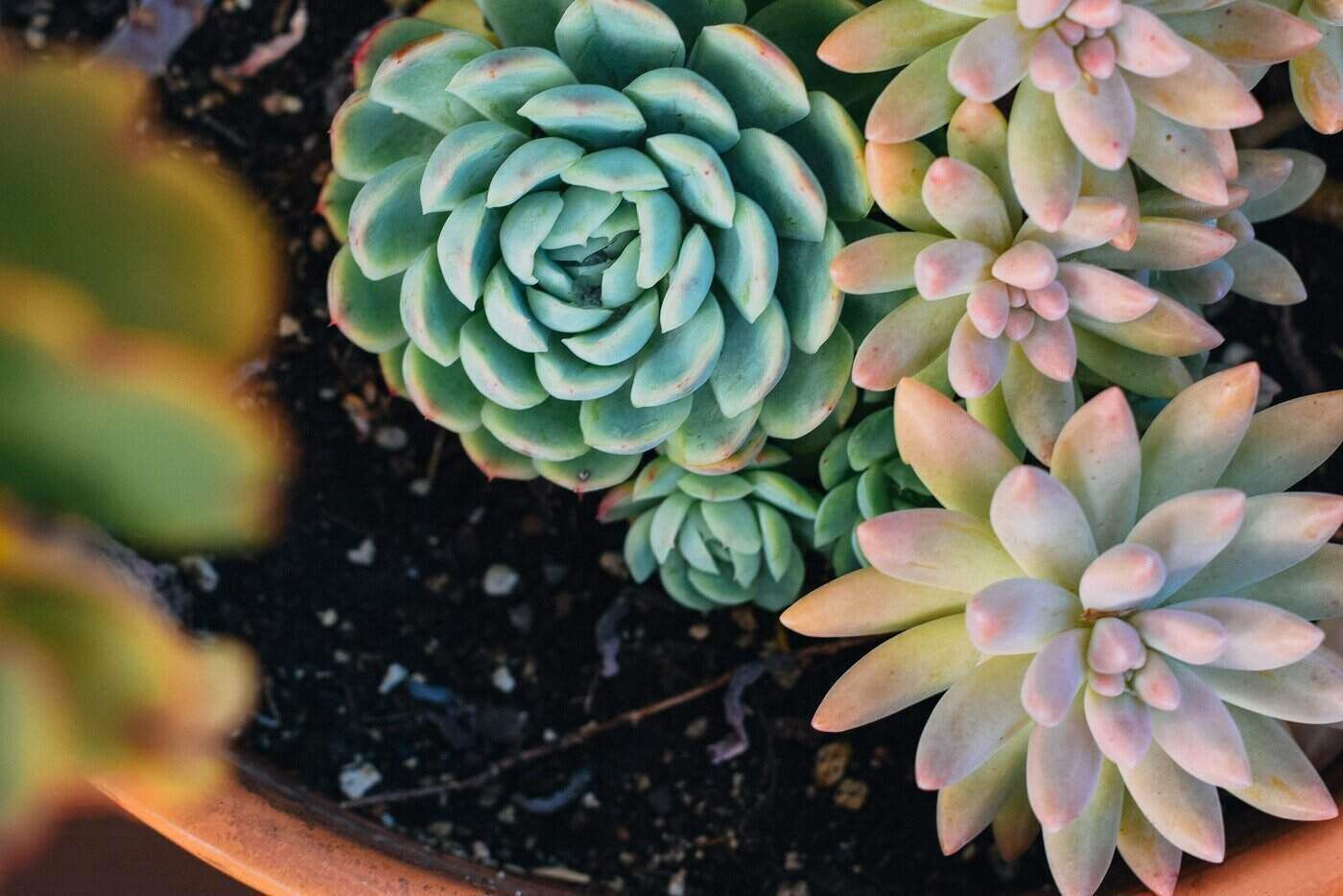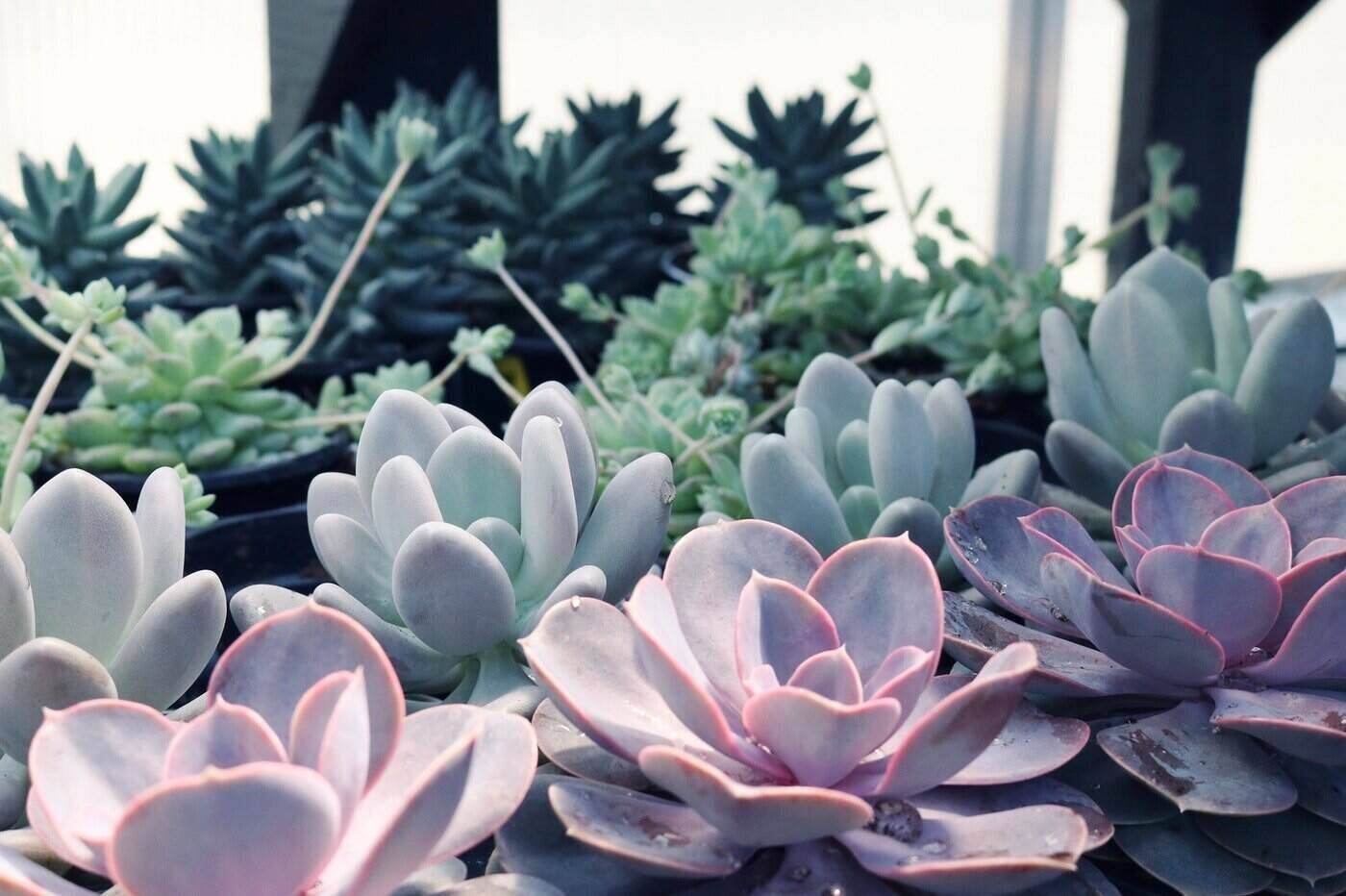For people who do not have the time and patience for fickle plants, echeveria is your guy. It requires little care, always looks great, forgives you if you have other stuff on the go and neglect it a bit and even reproduces itself.
If this sounds like a plant you could get into, let us take you deeper into their wonderful world.
Description of Echeveria
Echeveria (Echeveria) are succulents. Their thick leaves form lovely rosettes with a variety of leaf shapes and colors. Native to mountainous regions in Mexico, Central and South America, echeveria are naturally found in rocky terrain. They’re typically small plants, but depending on species, they can be up to 12 inches tall and wide (or more!).
There are 150 species of echeveria, as well as many, many hundreds of hybrids and cultivars. While they share the typical rosette shape, the similarities often end there. The foliage can be light or dark, and can have tones of gray, blue, pink, red, purple or silver. Variegated leaves and leaves with colored margins are also common. The leaves can be rounded, frilled, curled, fuzzy or pointed.
One of the best things about them is that they both already look like a flower and also produce uniquely beautiful flowers. Flowers are usually bell or star-shaped, atop tall, curving spikes. Blooms can be pink, red, orange, yellow or cream. The flowers on the spike will open in sequence, giving the plant a long-lasting flowering period. Flowers bloom in the summer and fall, depending on species.
What to Look for When Buying Echeveria
When buying echeveria, look for plants that are firm and full. The leaves shouldn’t feel mushy and they should stay attached if you lightly press on them. Leaves that detach easily are a sign of overwatering, which could also mean root rot.
Avoid plants with obvious physical damage, including burn spots and scars. The color should be vibrant, although on one of the many pale varieties of echeveria, vibrancy might be more difficult to judge. The stems should be compact and the rosette symmetrical – these are signs that the plant has had adequate light. New growth is always a good indicator of good plant health.
If you can, purchase your plants from a local nursery or farmer’s market, rather than a supermarket or big box store. Not only will you be supporting local businesses, but you’ll be getting a higher quality plant that’s been taken care of by people who specialize in taking good care of plants.
How to Grow Echeveria
Echeveria plants are grown indoors and out, and in both cases will be happiest if you can provide them with dry air and full sunlight.
Growing Echeveria Outdoors
As outdoor plants, many are hardy to USDA zone 8. None tolerate harsh winters, so in colder climates they’re most often grown as annuals or brought indoors over the winter. Echeveria are often grown in containers and flower beds. Slow-growing and low to the ground, they do well as a companion plant for other, taller species. Their range of complementary leaf shapes and colors make them charming to group together as a low-growing border plant. They’re a natural fit for rock gardens, and do well in vertical gardens, as well.
If you’re growing these plants outdoors, choose a location where they can get plenty of morning sun, but where they’ll be protected from full summer afternoon sun. They don’t do well in intense sunlight and their leaves can burn easily. It’s especially important to protect the leaves of your echeveria because the plant keeps them for a long time. Any damage to leaves will compromise your plant’s health for years to come.
Be careful with drastic changes in the amount of light your plant receives, as well. Take care when moving echeveria outdoors in the spring. Their leaves will need to be slowly acclimatized to the increase in daylight.
Growing Echeveria Indoors
If growing echeveria indoors, choose a south or a west-facing window for maximum sunlight. Be sure to rotate your echeveria so it grows evenly and doesn’t become lopsided if it reaches for sunlight.
Echeveria prefers well drained, rich soil that’s moist in the spring and more on the dry side during winter, when the plant isn’t actively growing. Pots with excellent drainage are a must. Small pots are perfect for these little plants – they thrive in pots that are slightly larger than their root ball.
When watering, avoid watering the plant directly – water the soil instead. Soaking the soil and then letting it dry out completely before watering again will keep the roots healthy and happy.
These hardy plants don’t require regular fertilizer. If you feel your plant needs a little extra help, a slow-release fertilizer, or fertilizer that’s specific for succulents is recommended.
Getting Your Indoor Echeveria to Flower
Indoor growers might be wondering how to make these plants flower. The first thing to know is that, as succulents, echeveria need to be mature before they can produce flowers. It might be years before yours is ready.
The second thing to know is the species of your echeveria – finding out its species will help you determine when it naturally blooms so you can try to reproduce the conditions that the plant needs to flower. Warmer temperatures and more intense sunlight will usually be part of those conditions. You can try to recreate them by moving your plant to a sunnier spot or using a grow light if your growing space is dim.
You can hand-pollinate the flowers and try to produce seeds or trim the flower stem back once the flowers are spent. Many people simply remove the flower stem altogether to save the plant’s energy.
Propagating Echeveria
Echeveria is incredibly easy to propagate. They will produce offsets, which can be separated from the mother plant and repotted in cactus mix or potting soil. You can also take leaf cuttings. Allow the leaf to cauterize for at least a day, then place the cut leaf on the soil surface. Within a few weeks, the leaf will root and produce a new rosette.
If your echeveria starts to look spindly, you can revive it and create two or more new plants in the process. First remove the plant from its soil. With a sterilized knife, cut the rosette off an inch or two below the lowest firm leaf, making sure to remove the withered lowest leaves first. Leave both the stem and the rosette out for at least a day to cauterize. Replant the stem half and place the rosette half on new prepared soil. Within a few weeks, the rosette will root and the stem half produce new offsets, which can be removed and replanted as above.
Things to Watch Out For
If your echeveria becomes flat, or if its new growth is pale, move the plant to a sunnier spot. Likewise, if its stem starts to stretch out, that’s a sign that it needs more light. The good news is that if your echeveria does stretch out over the winter, you can cut the rosette off in the spring and replant it.
Root rot is likely to occur when the plant has been overwatered. Leaves that start to wrinkle, wilt or drop are a good sign of overwatering. Be on the lookout for mealybugs and thrips, especially in areas of high humidity. Aside from that, echeveria tend to be resistant to diseases and pests, including deer and rabbits.
Arranging Echeveria
Although echeveria flowers themselves are lovely, their foliage is really the star of the show. The plants make for unique living floral designs that are also perfectly suited for people who like practicality in their floral arrangements.
These plants require little care and won’t drop their leaves (unless they’re regularly overwatered). They can be repotted and used as houseplants whenever anybody likes, and they regularly produce other plants. You can’t say that about a cut arrangement.
Container Considerations
Echeveria look so great on their own that a single echeveria in a classic or a whimsical pot can make a respectable and welcome gift plant. With so many varieties to choose from and combine, however, it’s often more fun to group these little plants.
They don’t need much soil, which opens up a lot of playful planting options. They’re a solid choice for vertical gardens and living walls. Driftwood or branch planters also make gorgeous settings for these vibrant succulents. Natural materials including rock and moss can be used as a backdrop to blend plant and planter into a seamless whole.
For something more high-impact, glass or metal bowls and containers look striking against a mini-garden of these lovelies. Just be sure your choice of container has adequate drainage.
Design Considerations
Echeveria allow you to work in cool or warm palettes, and to create pieces with subtle or high contrast. Their many shapes and textures also make them wonderful plants to create monochromatic arrangements with.
Consider pairing them with other types of succulents to create designs that can be bolder with shapes. The beautiful symmetry of the echeveria rosette can be nicely enhanced when it’s placed next to taller cacti or aloe.
Choose larger echeveria varieties with dramatic shapes or textures to give visual interest to a piece. Or blend plants with complementary shapes and textures together to create something lower impact. It’s easy to create layers and levels with different species. Since they’re small, compact and stay where you put them, it’s also easy to create the lines you want in your potted arrangements.
These plants are perfect for living wedding centerpieces that guests can take home as favours. They make charming boutonnieres and corsages, as well. They can even make unique and gorgeous bouquets. This option is especially practical for summer weddings, since these succulents won’t wilt or droop, regardless of how hot the day gets.
For the holidays they make stunning living wreaths and super cute succulent Christmas trees. However you arrange your echeveria, they’re sure to look beautiful, even if your floristry skills are still in development.
If you haven’t explored these beautiful little plants yet, this is the perfect time to get acquainted. Be forewarned, though – they are very easy to love and you might find yourself with a new collecting hobby you never intended to have.
Feature image: Tim Gouw; Image 1: Madison Inouye; Image 2: Skyler Ewing



Thank you!!1
An great review and an absolutely stunning plant family